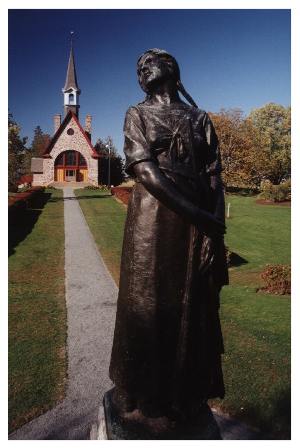 |
January 23, 2004Celebrations Galore in 2004
|
Today I want to put some celebrations of history scheduled for 2004 in perspective.
Champlain & Acadia 1604
With Samuel de Champlain Provincial Park near Mattawa in the heart of the Community Voices area it is fitting that we recognize the 400th Anniversary of his arrival in the New World and his contribution to Canadian history.
When he arrived there were numerous ships, outposts and activities on the East Coast and along the St. Lawrence River, but all were seasonal. Champlain wanted more and encouraged settlement year round. Before he died he had helped establish a transportation and economic philosophy that encouraged and established settlement. Volumes have been written on the power struggles and settlement efforts including early British efforts in Newfoundland and Scottish efforts in New Scotland (Nova Scotia).
2004 also remembers the 250th Anniversary of the expulsion of the French from Acadia. The British had been in power for 30 years (1713-1743) when circumstances made them nervous about the French even though they were neutral. As has been the case many times before in history an expulsion was determined to be necessary. It didn't have to be as ruthless as it was. A federal government proclamation acknowledging the wrongs done to their ancestors was received and celebrated by Acadians last month.
The British called hundreds of Acadians to Grand Pré in 1755 and told them they were being put on ships immediately and taken to the American colonies, the West Indies, Cape Breton, Newfoundland, etc. They were not able in many cases to take their wives, children or friends, which resulted in unnecessary and prolonged pain. Many died on the crowded ships. There were other expulsions later, with 11,000 people eventually displaced. In each case the homes and properties were destroyed.
Over the years some were sent from the colonies to England and some went back to France. Eventually many returned to the Maritimes - primarily in New Brunswick where they began to rebuild their lives. It is ironic that Robert Monckton the British Officer in charge of the expulsion had his name preserved in the name of the city of Moncton, New Brunswick, the centre of the Acadian population today.
This summer and next some 300,000 Acadians will celebrate their past in many events. There will be a World Congress in August 2004 and there will be an Acadian Day on July 28th, 2004
Longfellow's Evangeline
American poet Henry Wadsworth Longfellow (1804-1882) wrote a powerful nostalgic poem in 1847 about the expulsion of the Acadians a hundred years after the event. It is called Evangeline and tells the fictitious story of a young woman and man separated by the expulsion only to meet years later. The poem has been translated into French and a statue of Evangeline has been placed at the Church at Grand Pré. In 1997 10,000 Acadians gathered at Grand Pré to celebrate the 150th anniversary of the writing of the poem. These few lines from the last verse of the poem show that it was a slow start to the successful rebirth of the
Acadians:
Still stands the forest primeval; but
under the shade of its branches
Dwells another race with other customs
And language
Only along the shore of the mournful
And misty Atlantic
Linger a few Acadian peasants
Whose fathers from exile
Wandered back to their native
Land to die in its bosom
 |
Memorial Church and Evangeline Statue at Grand-Pre National
Historical Site of Canada.-Photo from the Société Promotion Grand-Pré and François Gaudet.
|
The Louisiana Purchase 1804 and the St. Louis World Fair 1904
When France sold Louisiana, a huge area from the gulf of Mexico to the Great Lakes, to the U.S. it doubled the size of the country and was instrumental in creating the future United States as we know it today. Some expelled Acadians were comfortably entrenched there before that date and many remain today. They are known as Cajuns. Many join the Maritime celebrations.
In 1904 one of the best World Fairs of all time took place in St. Louis Missouri with a major theme the celebration of the Louisiana Purchase in 1804. This year there will be a Worlds Fair Centennial "extravaganza" beginning April 30, 2004 in St. Louis. For information log on to
http://www.worldsfairstlouis.org./opening_weekend.html
Historians have pegged the St. Louis World Fair as the beginning of the junk food age as ice cream, hot dogs, popcorn and peanut butter were featured. On the other hand new technology was featured including motion pictures, the telephone and the phonograph.
An Historical Footnote
Simon Newcomb (1834-1909) the "worlds top astronomer at the turn of the century" who was born in Nova Scotia is featured in this months issue of the newly designed The Beaver, "Canada's History Magazine". As a teenager he ran away from
Moncton, New Brunswick to eventually become a brilliant astronomer and mathematician who provided outstanding leadership throughout his life. To jump from Moncton back to the St. Louis World Fair - the article states that a fellow scholar at the St. Louis World Fair stated that Newcomb is "perhaps of all Americans, the most honoured throughout the world among his peers in the realm of science". The article also makes an interesting case for Newcomb being the model Conan Doyle used for Sherlock Holmes' brilliant arch rival Professor Moriarty in his many mystery stories. So with all this celebrating going on lets raise a cup to the Beaver Magazine, Simon Newcomb and Sherlock Holmes - it's elementary my dear Watson.
Heritage Perspective Home Page
|

![]() Past
Forward is now on Facebook "LIKE" us to keep in touch
Past
Forward is now on Facebook "LIKE" us to keep in touch